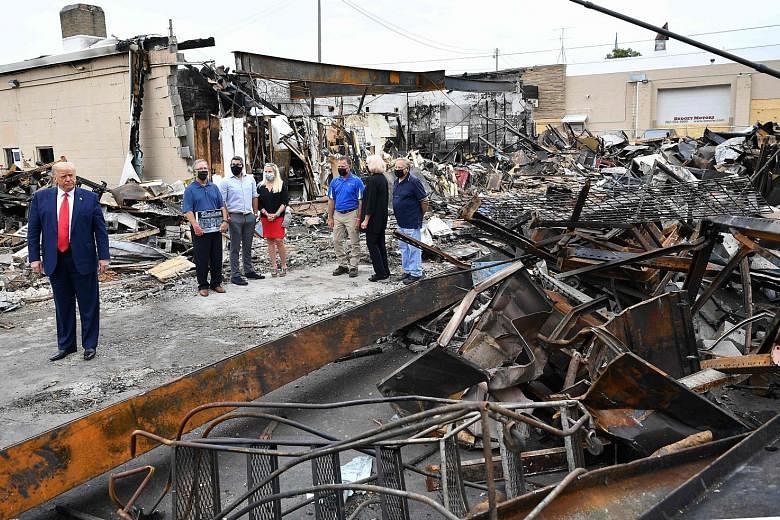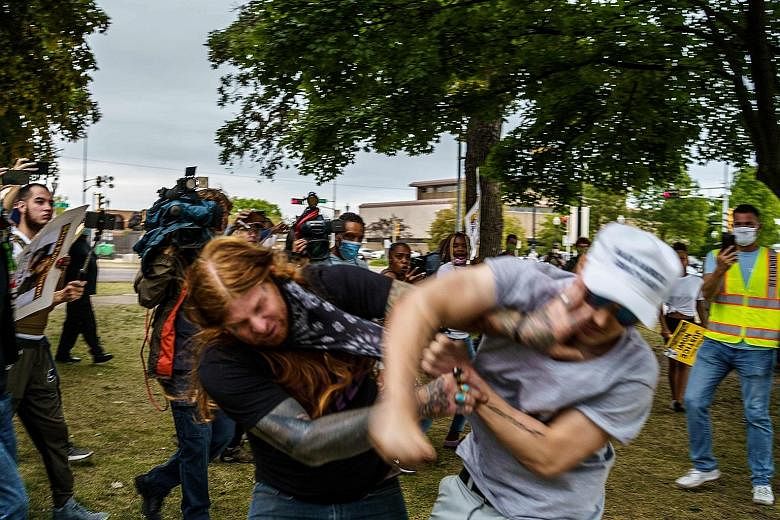United States President Donald Trump's visit on Tuesday to Kenosha, the Wisconsin city devastated by riots over the shooting of a black man by police, was an occasion to double down on his law and order message as a key driver of his re-election campaign.
The visit focused on the riot-hit parts of the city and on law enforcement. The President had the US Attorney-General William Barr at his side.
Mr Trump also pledged several million dollars to revive the city.
"Loss of business and loss of property is staggering," Mr Riki Tagliapietra, a local businessman helping to lead a rebuilding effort, told him at a meeting with local business leaders and Republican politicians as Democrats stayed away.
Governor Tony Evers, a Democrat, had advised Mr Trump not to visit, saying it would exacerbate tensions.
Mr Trump did not meet the family of Mr Jacob Blake, whose shooting on Aug 23 triggered the initial protests against police racism and brutality. He also did not mention the deadly incident on Aug 25, when 17-year-old white teenager Kyle Rittenhouse - since charged with homicide - shot three people, killing two of them.
Politically, the visit made sense. Wisconsin, with 10 all-important Electoral College votes, is a swing state which Mr Trump won in 2016 by fewer than 25,000 votes.
Meanwhile, the presidential race has tightened. An Emerson College poll conducted on Sunday and Monday found that President Trump has tightened the race to a two-point margin and is now trailing former vice-president Joe Biden by 49 per cent to 47 per cent. In July, Mr Biden held a four-point lead - 50 per cent to 46 per cent.
"It's all Democrats! Everything's Democrat! All these problems are Democrat cities," President Trump said, referring to the unrest that has roiled several cities.
"Violent mobs demolished or damaged at least 25 businesses, burned down public buildings, and threw bricks at police officers - which your police officers won't stand for, and they didn't stand for it," he said at the meeting.
"These are not acts of peaceful protest, but really domestic terror.
"We're hiring more police, surging tough-on-crime federal prosecutors, increasing penalties for assaulting law enforcement and for dismantling Antifa," he added.
Members of Antifa - the name comes from anti-fascism - usually appear at demonstrations dressed in black with face coverings and have often fought with police and attacked property.
But Antifa is organisationally amorphous, described by analysts as more like a network.
And while Mr Trump has been calling for the classification of Antifa as a domestic terror group, analysts see that as intensely political. White militias have also appeared at the protests, especially lately in Portland, Oregon, and in Kenosha.
Reports have not established that Rittenhouse, who used a semiautomatic rifle, was formally a member of any group. But he was not of age to own such a weapon and he also crossed state lines with it, which is illegal. Police allowed him, as well as armed white militia, to be on the streets despite curfew orders.
At a press briefing on Monday, President Trump, when asked whether he would condemn the 17-year-old, seemed to defend him, suggesting he had been acting in self-defence - which is the argument of the shooter's lawyer.
"It seems abundantly clear that Donald Trump is staking his re-election on what he calls the issue of law and order," Professor of American Studies at Cornell University Glenn Altschuler told The Straits Times.
That means "essentially trying to stoke fear among Americans at the prospect of looting, arson and anarchy in their communities; and anger against protesters for racial justice by equating them with anarchists, looters, arsonists and so on. That was the theme of the Republican National Convention… and he is now doubling down on that strategy".


